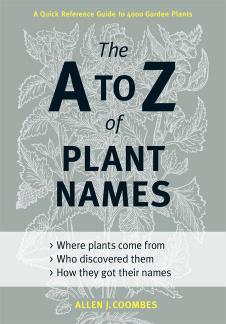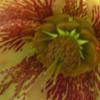
My reaction on receiving The A to Z of Plant Names by Allen J Coombes through the post from Timberpress was one of fascination and interest. I always find the stories about how plants were found and by whom interesting so to see ‘Who discovered them’ etc on the cover really caught my attention.
I have spent a little time learning about how plant names are constructed so I have a very basic understanding but I did struggle to make the leap to the next stage where this book seems to sit. The section on origin and meaning of plant names was very interesting, explaining that for example where chinensis is part of the plant name it probably comes from China. I found the section on how the epithet of the name – that’s the second word – is often an adjective and therefore being Latin has to follow the gender of the species interesting. I must admit that I re-read this section many times and was completely bewildered although having just re-read it sentence by sentence I think I have cracked what the author is saying. I suspect this is a case of the author being very familiar with his subject and not necessarily realising that he may need to take a step back when explaining what are to many quite complicated ideas. I also think the book would benefit from a short section which breaks down plant families, explaining all about species and genera etc.
There is also a short section on Common Names and Name Changes explaining why the powers that be choose to change the names we are familiar with. I particularly liked the section on Pronunciation section, in this the author observes that Latin is rarely spoken and that the best approach is to pronounce every vowel separately except when there are two vowels together which are pronounced as one. The example given is that Abies is pronounced as ab-ee-ayz not ay-beez.
The final section of the introduction is a list of common epithets and their meaning which is interesting and very helpful when you are reading about a plant in a book or catalog and wondering what it may look like. So ruber/rubra/rubrum (don’t forget the adjective follows the gender of the species!) means red and tortuosus/tortuosa/tortuosum means twisted.
The remainder of the book is a quick reference to some 4000 garden plants and it was at this point I became completely mystified. I had read the ‘How to use this book’ section but still couldn’t decipher the first entry without a lot of referring back to the how to section.:
“Abelia R. Br. (Linnaeccea) uh-bee-lee-uh. After Clarke Abel (1780-1826), British surgeon and naturalist who discovered and introduced A. chinensis. 5 spp shrubs. China, Japan
So this shows me how the pronounce the name and that the plant was named after a Mr Abel who had discovered it and when he lived. But what is ‘R. Br’ – the how to use section says each entry has the species epithet followed by the author – is that the mysterious R Br and if so who are they. Sadly there is no list that I could find of what these various abbreviations stand for and I am now intrigued.
Anyway, this irritation aside it is quite fascinating to have a mooch through the book looking up plants you know. I discovered that Delphinium got their name for the Greek for dolphin since each flower is supposed to resemble one. Lobelia is named after Mathias de L’Obel a Flemish botanist (1538 – 1616) and it goes on. You can also discover from where plants originate and this is very useful in deciding if they might be hardy, half-hardy or tender. So Canna originates from the Tropics and subtropical America so more than likely not very hardy in my UK garden.
I suspect I will use this book from time to time but I think for it to appeal to a wider audience it needs some additions of basic background information on plant name structure and families.

